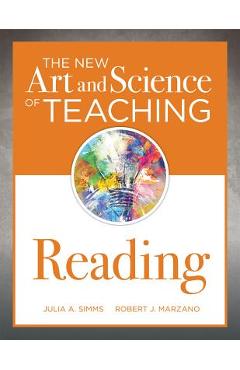The New Art and Science of Teaching Reading: (how to Teach Reading Comprehension Using a Literacy Development Model) - Julia A. Simms

Detalii The New Art and Science
libris.ro
228.5 Lei
253.89 Lei
Education
Julia A. Simms
The New Art and Science - Disponibil la libris.ro
Pe YEO găsești The New Art and Science de la Julia A. Simms, în categoria Education.
Indiferent de nevoile tale, The New Art and Science of Teaching Reading: (how to Teach Reading Comprehension Using a Literacy Development Model) - Julia A. Simms din categoria Education îți poate aduce un echilibru perfect între calitate și preț, cu avantaje practice și moderne.
Preț: 228.5 Lei
Caracteristicile produsului The New Art and Science
Comandă The New Art and Science Online, Simplu și Rapid
Prin intermediul platformei YEO, poți comanda The New Art and Science de la libris.ro rapid și în siguranță. Bucură-te de o experiență de cumpărături online optimizată și descoperă cele mai bune oferte actualizate constant.
Descriere magazin:
Part of The New Art and Science of Teaching series Only when teachers have in-depth knowledge of reading skill and literacy development can they deliver best-practice reading assessment and instruction to students. The New Art and Science of Teaching Reading presents a compelling model for the stages of reading development, structured around five key topics: (1) foundational skills, (2) word recognition, (3) reading fluency, (4) vocabulary, and (5) reading comprehension. More than 100 reading-focused instructional strategies are laid out in detail to help teachers ensure every student becomes a proficient reader. Guide students at all stages of literacy development, from learning the basic concepts of print to demonstrating advanced reading comprehension. Discover a research-based reading model to guide your instruction: Understand how to best utilize The New Art and Science of Teaching framework for teaching reading comprehension and other reading skills. Explore a reading model that addresses how to articulate content, implement specific instructional strategies, and navigate reading-related issues that might arise in the classroom. Understand which elements of instruction are best suited for teaching reading. Explore how general strategies for teaching can be employed alongside specific strategies to enhance teaching, enrich learning and literacy development, and improve the classroom environment. Access free reproducibles, including exercises, games, and readings for the classroom. A joint publication of ASCD and Solution Tree Contents: Introduction Chapter 1: Reading Research and a Reading-Specific Model of Instruction Chapter 2: Providing and Communicating Clear Learning Goals Chapter 3: Using Assessments Chapter 4: Conducting Direct Instruction Lessons Chapter 5: Conducting Practicing and Deepening Lessons Chapter 6: Conducting Knowledge Application Lessons Chapter 7: Using Strategies That Appear in All Types of Lessons Chapter 8: Using Engagement Strategies Chapter 9: Implementing Rules and Procedures Chapter 10: Building Relationships Chapter 11: Communicating High Expectations Chapter 12: Developing Expertise Appendix A: The New Art and Science of Teaching Framework Appendix B: Orthography Exercises Appendix C: Reading in the Disciplines Appendix D: Pho Part of The New Art and Science of Teaching series Only when teachers have in-depth knowledge of reading skill and liter

Produse asemănătoare

Visual Art and the Urban Evolution of the New South
![]() anticexlibris.ro
anticexlibris.ro
Actualizat in 02/07/2025
83.98 Lei

The The Art of Godzilla x Kong: The New Empire, Hardback/***
![]() elefant.ro
elefant.ro
Actualizat in 02/07/2025
574.99 Lei

Art of Not Making. The New Artist / Artisan Relationship, Paperback/Michael Petry
![]() elefant.ro
elefant.ro
Actualizat in 02/07/2025
121.99 Lei
Produse marca Julia A. Simms

The New Art and Science of Teaching Reading: (how to Teach Reading Comprehension Using a Literacy Development Model) - Julia A. Simms
![]() libris.ro
libris.ro
Actualizat in 05/06/2025
228.5 Lei



